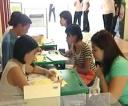Transformation of SMJK Dindings into a Smart School – Universiti Utara Malaysia
1.0 Introduction
Singapore, famous to be learning nation, successfully implemented IT in various level of school education system. In primary level, the students learn the basics in word processing, spreadsheet and graphics applications. After forming the foundation, they proceed to “enrichment classes” in upper secondary school, that would involve web publishing, programming and other projects such as DIY (do-it-yourself) PC assembly. However, by constant review in a survey done earlier last year, it was found that networking and multimedia skills are lacking. Surprisingly, in Malaysia, we have a school nested in the backwaters of Perak which have wired classrooms, whereby, unbelievably, the 16-17 years olds students could install and commission a fiber optic network. The very same kids are web publishers, proficient in C and Linux Programming. And it takes only one person to make a difference. Tiong, 48 years old, principle of SMJK Dindings, has single-handedly done to deploy IT at his school has amazed many, has transformed a village school to a smart school.
2.0 History
Sekolah Menengah Jenis Kebangsaan Dindings in Pundut, Lumut is surrounded by coconut trees and kampung houses in the middle of a palm oil plantation which lies 95 kilometres from the city of Ipoh. In 1992, the 38-year-old lower secondary school comprised a motleyset of wooden huts that made up the school office, classrooms and science laboratories. Hardly a place that would perhaps one day house a Smart School. Furthermore, it only catered to students up till Year Three. Its student population was made up mainly of children from the fishing, farming and smallholders community, as well as daily wage earners. According to Mr. Tiong, principal of SMJK Dindings, the school had only 320 students in 1992 .
However it has become the envy of other schools in the Manjung district since secondary school principal Tiong Ting Ming managed to secure the support and funds to turn it into a “cyberschool.” Public perception of the school has changed as parents of kids studying at the primary school next door now prefer to send their children to SMJK Dindings than move them elsewhere. Within the new building block at SMJK Dindings, a transformation of sorts of is taking place. The block — which houses 21 classrooms including a library, staffroom, computer room and science labs — is “network ready.”
The floor trunking and conduit piping has been built with UTP Cat 5 (Untwisted Pair Category 5) cables and other networking equipment, making up a large part of the building’s facade. Each room has a RJ-45 connector that gives it instant virtual access to the rest of the world. The new block was designed, and its building process supervised, by Tiong. SMJK Dindings intends to act as a role model of the networked school of the future.
Mr. Tiong Ting Ming is a chemistry graduate whose foray into technology began in 1984 when he helped set up and manage a computer club at another school. Since he was an Apple Macintosh fan, the club was equipped with a total of 30 Mac SEs and LCs, all networked together. He was ran the club for six years and learned everything there was to know about networking. When he was promoted to headmaster at SMJK Dindings in June 1992, he decided to use networking as the means to create a conducive environment for the students to learn about technology. In his opinion, the goal of education is to prepare students to become fully functioning participants in society. As IT becomes more pervasive, students need more than traditional skills to participate — they must be technologically-literate.

